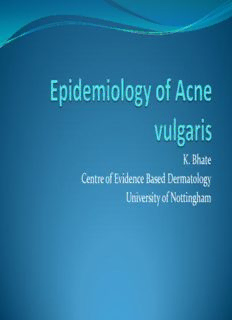
Epidemiology of acne vulgaris PDF
Preview Epidemiology of acne vulgaris
K. Bhate Centre of Evidence Based Dermatology University of Nottingham Overview Background Objectives and Method Findings Incidence Natural history Morbidity Socioeconomic impact Overview - 2 Genetics Ethnicity Diet Sunlight Hygiene Smoking Obesity Stress Infection One or two others.. Conclusion Background Epidemiology Incidence Prevalence Age, sex, social class Ethnic group and geography Natural history Risk factors for disease occurrence or progression Why is it important? Objective To provide a comprehensive review on the Epidemiology of Acne vulgaris (excluding acne rosacea, infantile acne, acne inversa) Baseline for future work Provocation trial Cohort study Methods Medline database (in process and other non-indexed citations 1946-present) Embase 1974 to the end of January 2012 NHS Evidence Acne vulgaris with epidemiology, aetiology, cause, prevalence, incidence, cost, pharmacoeconomics, socioeconomic, natural history, race, ethnicity, morbidity, quality of life, geography, family size, severity, excoriation, obesity, overweight, pathogenesis, washing, sweat, cleanse, sun, sunlight, light, diet, dairy, milk, GI, high GI, glycaemic/glycemic index, chocolate, hygiene, smoking, prevention, climate, environment, obesity, infection, Propionibacterium acnes (P. acnes), stress, picking, chloracne, drugs and medicine. Truncation to expand upon suffices No use of additional limits No pre-specified criteria for study exclusion or inclusion Results and Outcome Measures 173 papers included! Outcome measures How common is acne? All people between 15 and 17 15-20% classified as moderate to severe Prevalence data and 1996 census data - prevalence rate in 12-24 year olds 50% of 10 and 11 year old have more than 10 comedones and almost 80% of 8.5-12.2 year old had a degree of acne How long does acne last? Pre-pubertal children tend to have non-inflammatory acne – no sebum therefore no P. Acnes Average age of puberty has dropped over 15 years from 11.92 – 11.66 Persists into adulthood – 64% of 20-29 and 43% 30-39 and 3-5% 40-49 year olds How long does acne last? - problems Natural history difficult to assess - good availability of acne therapy therefore few high quality studies Can pre-pubertal treatment alter P. acnes colonisation and subsequent inflammatory acne?
Description: